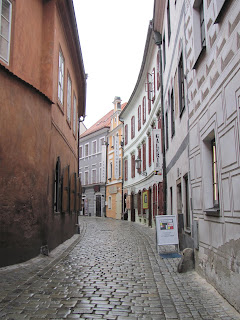Czechoslovakia became a nation in 1918. The new borders, drawn by the post WWI Treaty of Versailles, include the Sudetenland, a predominantly German area. When Hitler came to power in Germany in 1933, his goal is to unite all German speakers into one country, so his first target is the Sudetenland, which included Cesky Krumlov. To avoid another war, France and Britain sign the Munich Agreement officially giving the Sudetenland to German. Czech representation was not invited. The Czechs of the Sudetenland were transferred elsewhere and Germans moved into their homes. After the war, the roles were reversed as Germans were transferred from the Sudetenland, often using the same tactics as the Nazis had with armbands and cattle cars. Nationality, a concept created in the 19th century, ceased to be a choice by the 20th century.
Today, Cesky Krumlov is a town untouched by time, hidden in the bend of a river. Tourists are attracted because of the castle (not to mention the Vampire Princess, Eleonora who is doubly sealed into her grave under the church). Without knowing the history of the transfers, you would never know that some 70 years ago, Hitler marched through these very streets.



Did you know my grandma was one of those Germans who lived in Czechoslovakia in Sudetenland? She was forced to march to Germany when she was only three years old when the war started. She lived in a sort of internment camp when she made it to Germany with her family.
ReplyDelete